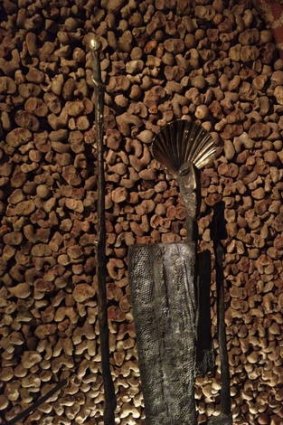This was published 11 years ago
Czeching out
Tim Richards confronts mortality in the city of Brno and finds beauty among the bones.

St James' Ossuary, Brno.Credit: Tim Richards
I'm looking Death in the eye, and Death is looking back at me. Strangely, it doesn't seem as creepy or disturbing as it should.
I'm standing beneath Jakubske Square, in the eastern Czech city of Brno, gazing at a thick circular column of human skulls and bones. They're brown with age and rise all the way from the floor to the ceiling of this cool, dimly lit chamber.
Nearby are two skeletons in caskets, with a wall of bones behind them. Soft instrumental music plays as I shuffle among a small group of hushed onlookers peering at these reminders of mortality.
There's no shortage of such memento mori in St James' Ossuary (entry $7). For almost 200 years, these underground chambers functioned as a final depository for those buried in the cemetery of St James' Church. When the cemetery became full, older bones were moved here.
After the cemetery was paved over in 1784, the macabre storehouse was forgotten. Then a routine archaeological dig in 2001 discovered a vast collection of 50,000 skeletons, second only to the famous catacombs of Paris.
The remains were in such an advanced state of decay, they were collapsing, causing a cavity that could one day swallow the square and the trams that run across it. The solution took more than a decade to implement: the bones were temporarily removed, the ossuary was strengthened and ventilated, then the human remains were returned.
What's fascinating is their arrangement in patterns, and the specially commissioned pieces of art that turn this bone storehouse into a place of contemplation.
As I stand in a side corridor, which ends in a tiered arrangement of skulls, what I'm mostly contemplating is whether this place is disrespectful to the dead.
The individuals who once owned these bones had already been rendered anonymous by being moved from the churchyard centuries ago, I reason. The artworks — typified by a striking rendition of Charon, the ancient Greek ferryman of the dead — seem tasteful, the music soothing, and the arranged bones thought-provoking.
The rebuilt ossuary is, I'm surprised to find myself deciding, quite a beautiful place.
Not that this is the only confrontation I'm going to have with the dead past in Brno. Just 500 metres south off Kapucinske Square is the Capuchin Crypt (entry $3), formerly used by the Capuchin Monastery as a place to lay deceased friars and other Brno notables to rest. Because the crypt was unusually well ventilated, there are no bones on display — instead the visitor encounters a series of desiccated mummies.
In pride of place is Baron Franz von Trenck, a devil-may-care adventurer who led a band of guerilla fighters in the 18th-century Austrian army and was eventually imprisoned in the local fortress, Spilberk.
Succeeding rooms contain the remains of nobles, including the disturbingly distorted body of one whom experts think might have been buried alive.
Then, in the final chamber, I meet numerous friars lying on their backs on the earth floor, many still wearing the cowled habits in which they were laid to rest. Because they're so recognisably human, the exhibits here at the crypt are far more creepy than those in the ossuary. However, I'm moved by the sign on the wall above the friars, translated as: "What you are, we were; what we are, you will be." Says it all, really.
Sign up for the Traveller newsletter
The latest travel news, tips and inspiration delivered to your inbox. Sign up now.